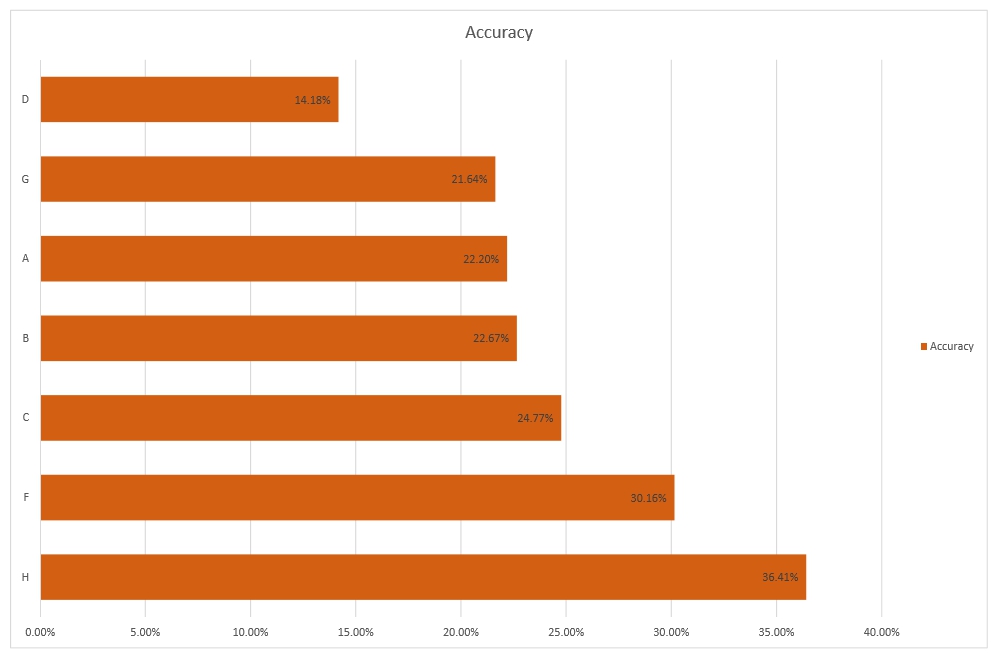|
 Over the last 10 weeks, eight cricketers have been conducting an experiment in improving their cricket. Today, I want to give you the results of that hard work. Over the last 10 weeks, eight cricketers have been conducting an experiment in improving their cricket. Today, I want to give you the results of that hard work.
This is both a story and an evidence-based piece of research. There are lessons to be learned about every aspect of cricket coaching; how to improve, how long it takes to see changes, how to manage unexpected situations, dealing with people and dealing with your own mental game. There's a tale here for you that has taken well over 30 hours to construct.
So, let's start the journey.
Why a case study?
We did it for several reasons.
First, we wanted to show you with real evidence the power of PitchVision at any level of cricket. We couldn't have produced this research without a way of tracking the results, and PitchVision provided data in dozens of measurable areas. Yet, it's useable by amateur players who can only train in their spare time.
Second, we had a group of players hungry for success. The eight club players from McCrea FS West of Scotland were devastated to be relegated last summer, and wanted to push their games forward as quickly as possible to be ready for a tough promotion fight. This was made easier by the club owning it's own indoor facility for use in any weather.
Finally, a case study focused the mind. It provided a clear start and end point for the players and the coach. The players all knew their performance would be on show to the world. Here is that show.
What was the set up?
The study was undertaken over nine sessions (10 weeks) between October and December 2015. Eight cricketers participated in the sessions, lasting two hours. Every session,
- Was held at a venue with two indoor net lanes
- Was run by one coach
- Used PitchVision in one lane
- Had the usual cricket equipment available (balls, stumps, bats, protective gear)
- Was run to a pre-agreed session plan. Every session had batting and bowling. Some sessions had catching and fitness-focused training.
Other equipment used during the sessions were Katchet ramps, incrediballs, weighted balls, dumbbells, resistance bands and a medicine ball, but these were not directly part of the study. A bowling machine was also used for some sessions.
Who took part?
The eight players who took part were aged 14-28. All are club players and range in experience from 3rd XI to semi-professional level. The only skill requirement was they could "hold their own" in every session without fear of mixing skill levels too much. The players were:
- A: Fast bowler with ambitions to bat higher in the order, 1st XI with full representative honours.
- B: Medium pace all rounder, 1st XI.
- C: Leg spinner, 1st/2nd XI.
- D: 18 year old batsman with ambitions to bowl off spin. 1st XI with age group representative honours.
- E: Batsman, 1st/2nd XI.
- F: 14 year old leg spin all-rounder. 3rd XI With age group representative honours.
- G: Batsman who bowls leg spin. 2nd XI.
- H: Fast bowler, 1st XI.
So, with three seamers, four spinners and six top order batsman, there was a good mix of skills.
It was a requirement for each player to have a pre-course meeting with the coach to set up their goals for the case study. Everyone had a different set of goals to try and meet. Every player was also asked to commit to attending every session, and have a post-course review of goals.
Results
Now here is the juicy part: What really happened?
We tracked a lot of data over the sessions, and came up with the following performance indicators:
- Volume: Balls bowled and balls faced
- Bowling accuracy
- Bowling pace
- Spin bowler deviation (turn)
Additionally, we ran a competition to see who could bowl the fastest ball on a good length, who was most accurate in a single session and who bowled/faced the most balls in a single session.
Volume
This is balls faced plus balls bowled on PitchVision. This was tracked because - in very basic terms - the more you bat and bowl, the better you get. This is always within the context of deliberate practice, which was employed for every player during the study.
"E" faced most balls in a single session (114) and "C" had an epic single session bowling 116 balls of leg spin in one go.

Bowling Accuracy
To give these figures some context, "accuracy" is the number of times you bowl a ball that lands in the defined target zone on the PitchVision mat. The benefits of hitting the right spot are obvious and as old as cricket; landing on a sixpence.
So, while the ideal is 100%, in reality, the highest ever on PitchVision anywhere in the world is 70% (one person), with only six people over 60%. So a realistic good result is 40%+.
Additionally, as several player were making changes to their bowling action, a lower overall % is to be expected.

Other factors that can't be shown in an accuracy percentage are:
- The size of the target zone (for example, "D" has set a very small target area, "F" was much larger).
- Pitch conditions (different pace pitches require different areas).
- Batsman response (you might bowl a good length ball and be hit for four or get the batsman to nick off).
- Luck (You might have a full toss hit straight to mid off).
- What the ball does before pitching (dip, drift, swing) and after pitching (turn, cut and seam).
With all these things in mind, it's important to remember that while more control is always better, being able to respond to different situations is a skill you can't measure.So these numbers provide both a benchmark, and a way to bowl indoors in the same way as you intend to bowl outdoors:
- We can set the target for an outdoor length (fuller than the indoor school) and you can get better at hitting it.
- You can view your success not by the batsman's response (for example if someone is slogging) but by the place on the pitch you hit.
- You can aim to improve your accuracy through deliberate practice (that is to say, bowling a ball, seeing where it lands, then bowling again)
- You can view your accuracy in a wider context rather than trying to remember good days and bad days.
Bowling Pace
Pace was measured using PitchVision. Bowlers had short run ups and no spikes (as indoors) Nevertheless, it was an excellent result to see "A" achieve an average of 71.93mph (115kph), topping out at 84.69mph (136mph). This is quick for club cricket. "H" is also a good club pace, averaging 65mph (104kph) with some balls over 70mph (112kph).
A success story in this category is "D" who decided to seriously take up off spin this year and has added 3mph to his average pace over the winter.

Turn
Turn, or in PV terms "deviation" is simple the amount the ball turned on hitting the PitchVision mat. It's measured in degrees and, for club players, is ideal between 2-4.

PitchVision provides a consistent measurement for individuals to work towards improving. It's important not to get hung up on this figure alone as pitches turn more and less through the season, and dip/drift isn't measured. However, it provides a rough yet consistent benchmark for the spinners that is better than pace alone.
What do these results mean?
So, that's the raw data with a little explanation of how it's used. But what else can we see in the data to help improve cricketers?
First, these sessions show how much work you have to do to improve.
20 hours of practice shakes down, on average, to 163 balls faced and 216 balls bowled per player. We can safely double that number for non-PV tracked balls (in the sencond net) to about 350 balls faced and 450 balls bowled. There is no doubt we have seen excellent improvements in individual techniques during this time but changes have come slowly and improvements have been small.
It's clear that to see major improvements, much more time is needed: Perhaps 3000 balls faced and balls bowled on PitchVision, or 120 hours of training (excluding fielding practice). Naturally, this is intimidating to cricketers who want fast results. So, break it down further using the 10 hour rule.
For example, the next aim for this group is a minimum of another 200 of both balls faced and balls bowled on PitchVision before the season begins (in around 20 weeks). This will make a significant difference in the short term, but will also allow a focus on the longer term goal of the right volume for mastery.
Secondly, it's clear that more pace is always better as long as accuracy is also good. The aim should be to add 10% ore more to every player's speed before the start of the season. This can be done with S&C, heavy ball bowling, technical tweaks and the right volume (for seamers this is following the 7/4/2 system of bowling four times a week, never more than two days in a row).
This is also true for spinners. If you are turning the ball and hitting the spot, you will be harder to play at 45mph than at 35mph. You can use fast bowler tricks to up the pace.
Lastly, speaking of spinners, it's clear tracking pace, deviation and accuracy together will allow you to decide on a tactical approach. Look at how deviation influences pace and accuracy and from these three data points decide how best to bowl in any given situation (give it a rip, dart it in, best line and sets of ball to winkle a batsman out).
Any questions?
And now I want to know, what more you would like to know.
We have so much logged it's easy for you to ask more about specifics. Do you want to know how pace influenced accuracy? Are you interested in the effect of volume on player motivation and confidence?
Ask away and we will get you the answers you want from this great vault of data and experience!
Discuss this article with other subscribers
|

.jpg)

.jpg)

.jpg)

.jpg)